NUR302: Case Study of RN Leadership in a Collaborative Healthcare Team
VerifiedAdded on 2022/08/22
|9
|2952
|32
Essay
AI Summary
This essay evaluates a case study focusing on Mrs. Konstantina Galanos, a 79-year-old patient admitted for a leg amputation due to diabetes-related complications, and discusses the role of the registered nurse (RN) within a collaborative healthcare team. The essay identifies key nursing priorities, including managing Mrs. Galanos's anxiety, addressing her diabetes, and ensuring proper care for her permanent colostomy. It emphasizes the RN's leadership in coordinating care, communicating with the multidisciplinary team (including surgeons, dieticians, and diabetes specialists), and advocating for patient safety and needs, such as language barriers. The essay explores how RNs can apply clinical leadership principles like communication, problem-solving, and advocacy to improve patient outcomes, reduce hospital stays, and enhance patient satisfaction. The analysis highlights the importance of the NMBA Standards of Practice and the Decision-making framework for nursing and midwifery in guiding RNs' actions and promoting effective collaboration within the healthcare team to provide comprehensive and patient-centered care.

Running head: CASE STUDY
Case study
Name of the student:
Name of the University:
Author’s note
Case study
Name of the student:
Name of the University:
Author’s note
Paraphrase This Document
Need a fresh take? Get an instant paraphrase of this document with our AI Paraphraser
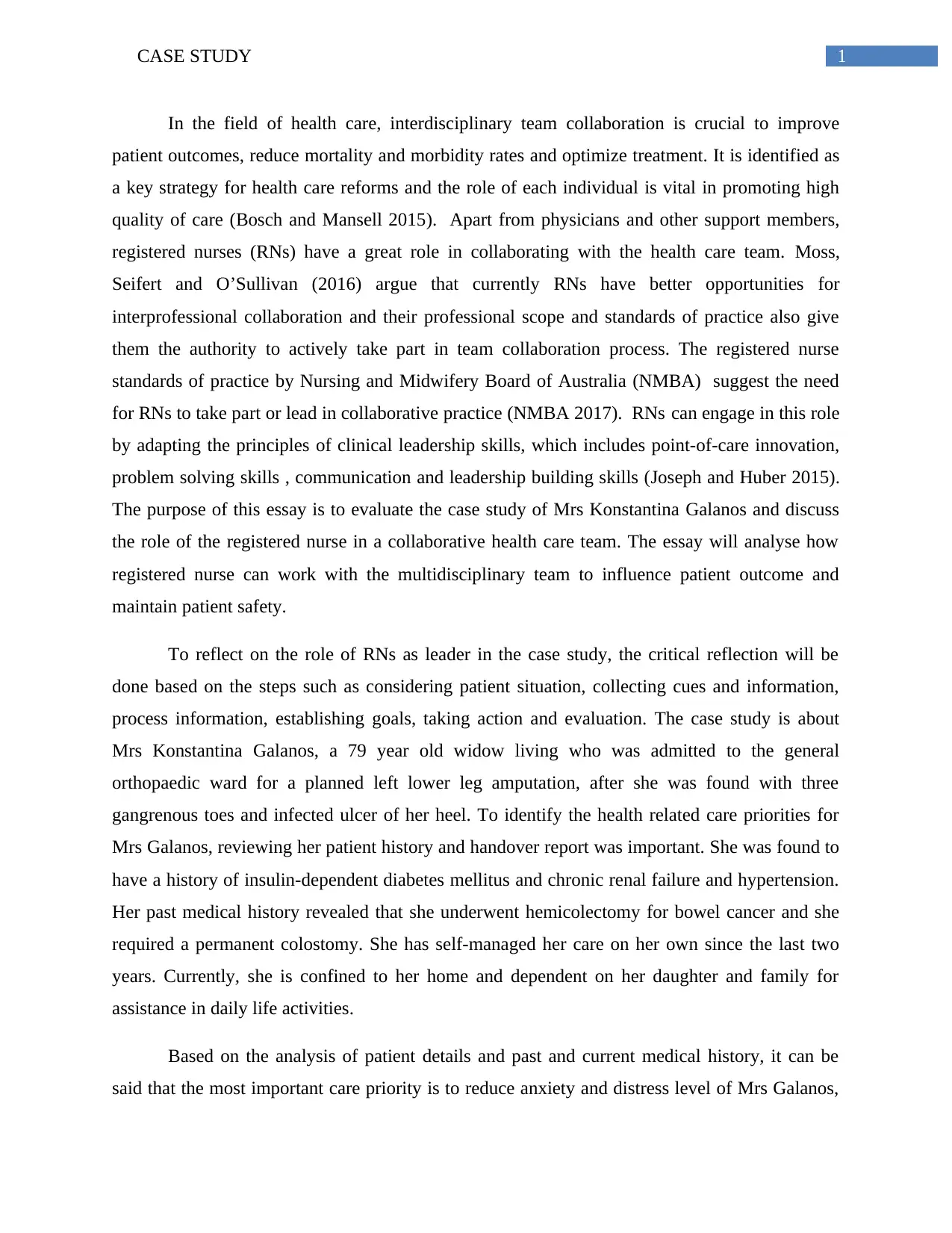
1CASE STUDY
In the field of health care, interdisciplinary team collaboration is crucial to improve
patient outcomes, reduce mortality and morbidity rates and optimize treatment. It is identified as
a key strategy for health care reforms and the role of each individual is vital in promoting high
quality of care (Bosch and Mansell 2015). Apart from physicians and other support members,
registered nurses (RNs) have a great role in collaborating with the health care team. Moss,
Seifert and O’Sullivan (2016) argue that currently RNs have better opportunities for
interprofessional collaboration and their professional scope and standards of practice also give
them the authority to actively take part in team collaboration process. The registered nurse
standards of practice by Nursing and Midwifery Board of Australia (NMBA) suggest the need
for RNs to take part or lead in collaborative practice (NMBA 2017). RNs can engage in this role
by adapting the principles of clinical leadership skills, which includes point-of-care innovation,
problem solving skills , communication and leadership building skills (Joseph and Huber 2015).
The purpose of this essay is to evaluate the case study of Mrs Konstantina Galanos and discuss
the role of the registered nurse in a collaborative health care team. The essay will analyse how
registered nurse can work with the multidisciplinary team to influence patient outcome and
maintain patient safety.
To reflect on the role of RNs as leader in the case study, the critical reflection will be
done based on the steps such as considering patient situation, collecting cues and information,
process information, establishing goals, taking action and evaluation. The case study is about
Mrs Konstantina Galanos, a 79 year old widow living who was admitted to the general
orthopaedic ward for a planned left lower leg amputation, after she was found with three
gangrenous toes and infected ulcer of her heel. To identify the health related care priorities for
Mrs Galanos, reviewing her patient history and handover report was important. She was found to
have a history of insulin-dependent diabetes mellitus and chronic renal failure and hypertension.
Her past medical history revealed that she underwent hemicolectomy for bowel cancer and she
required a permanent colostomy. She has self-managed her care on her own since the last two
years. Currently, she is confined to her home and dependent on her daughter and family for
assistance in daily life activities.
Based on the analysis of patient details and past and current medical history, it can be
said that the most important care priority is to reduce anxiety and distress level of Mrs Galanos,
In the field of health care, interdisciplinary team collaboration is crucial to improve
patient outcomes, reduce mortality and morbidity rates and optimize treatment. It is identified as
a key strategy for health care reforms and the role of each individual is vital in promoting high
quality of care (Bosch and Mansell 2015). Apart from physicians and other support members,
registered nurses (RNs) have a great role in collaborating with the health care team. Moss,
Seifert and O’Sullivan (2016) argue that currently RNs have better opportunities for
interprofessional collaboration and their professional scope and standards of practice also give
them the authority to actively take part in team collaboration process. The registered nurse
standards of practice by Nursing and Midwifery Board of Australia (NMBA) suggest the need
for RNs to take part or lead in collaborative practice (NMBA 2017). RNs can engage in this role
by adapting the principles of clinical leadership skills, which includes point-of-care innovation,
problem solving skills , communication and leadership building skills (Joseph and Huber 2015).
The purpose of this essay is to evaluate the case study of Mrs Konstantina Galanos and discuss
the role of the registered nurse in a collaborative health care team. The essay will analyse how
registered nurse can work with the multidisciplinary team to influence patient outcome and
maintain patient safety.
To reflect on the role of RNs as leader in the case study, the critical reflection will be
done based on the steps such as considering patient situation, collecting cues and information,
process information, establishing goals, taking action and evaluation. The case study is about
Mrs Konstantina Galanos, a 79 year old widow living who was admitted to the general
orthopaedic ward for a planned left lower leg amputation, after she was found with three
gangrenous toes and infected ulcer of her heel. To identify the health related care priorities for
Mrs Galanos, reviewing her patient history and handover report was important. She was found to
have a history of insulin-dependent diabetes mellitus and chronic renal failure and hypertension.
Her past medical history revealed that she underwent hemicolectomy for bowel cancer and she
required a permanent colostomy. She has self-managed her care on her own since the last two
years. Currently, she is confined to her home and dependent on her daughter and family for
assistance in daily life activities.
Based on the analysis of patient details and past and current medical history, it can be
said that the most important care priority is to reduce anxiety and distress level of Mrs Galanos,
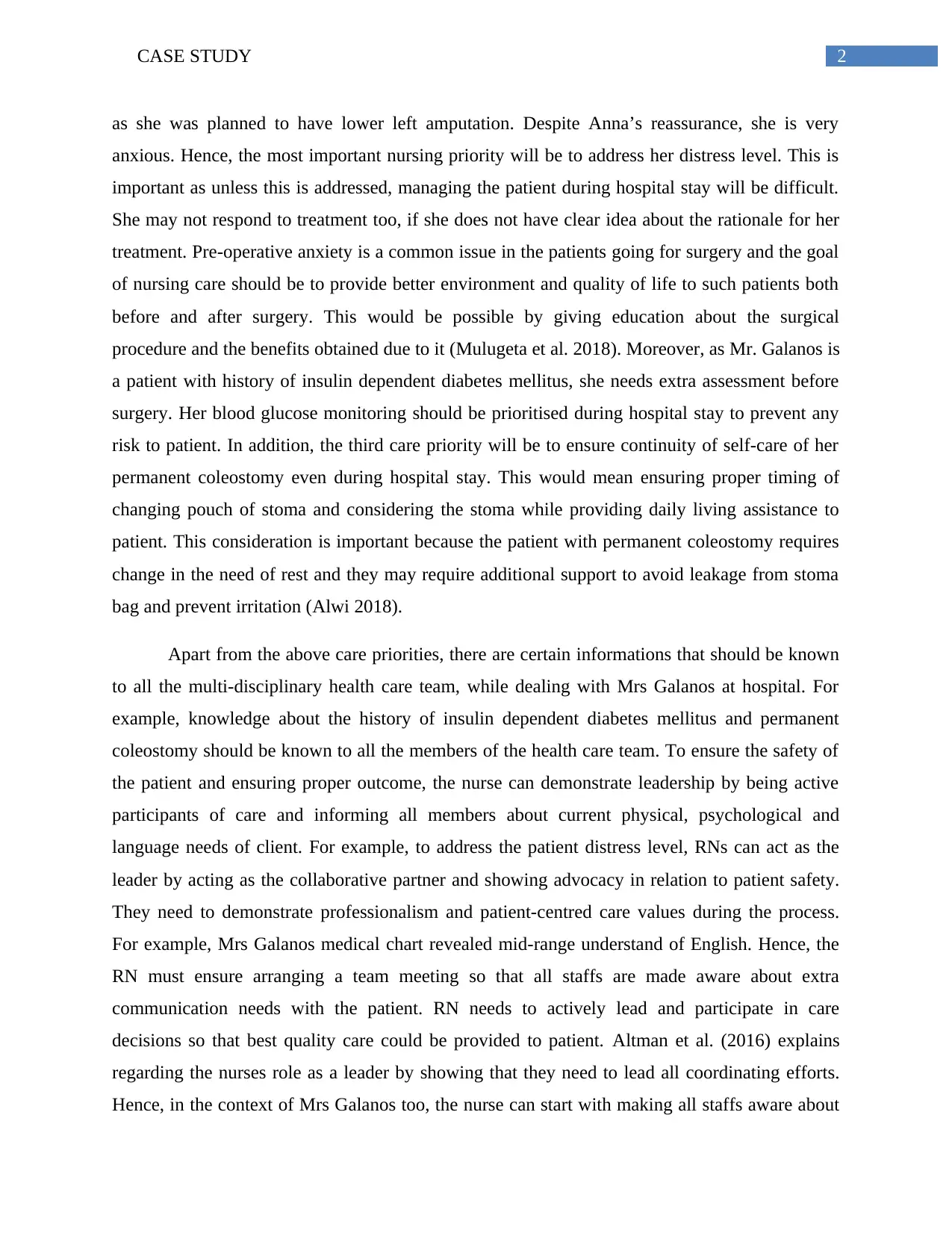
2CASE STUDY
as she was planned to have lower left amputation. Despite Anna’s reassurance, she is very
anxious. Hence, the most important nursing priority will be to address her distress level. This is
important as unless this is addressed, managing the patient during hospital stay will be difficult.
She may not respond to treatment too, if she does not have clear idea about the rationale for her
treatment. Pre-operative anxiety is a common issue in the patients going for surgery and the goal
of nursing care should be to provide better environment and quality of life to such patients both
before and after surgery. This would be possible by giving education about the surgical
procedure and the benefits obtained due to it (Mulugeta et al. 2018). Moreover, as Mr. Galanos is
a patient with history of insulin dependent diabetes mellitus, she needs extra assessment before
surgery. Her blood glucose monitoring should be prioritised during hospital stay to prevent any
risk to patient. In addition, the third care priority will be to ensure continuity of self-care of her
permanent coleostomy even during hospital stay. This would mean ensuring proper timing of
changing pouch of stoma and considering the stoma while providing daily living assistance to
patient. This consideration is important because the patient with permanent coleostomy requires
change in the need of rest and they may require additional support to avoid leakage from stoma
bag and prevent irritation (Alwi 2018).
Apart from the above care priorities, there are certain informations that should be known
to all the multi-disciplinary health care team, while dealing with Mrs Galanos at hospital. For
example, knowledge about the history of insulin dependent diabetes mellitus and permanent
coleostomy should be known to all the members of the health care team. To ensure the safety of
the patient and ensuring proper outcome, the nurse can demonstrate leadership by being active
participants of care and informing all members about current physical, psychological and
language needs of client. For example, to address the patient distress level, RNs can act as the
leader by acting as the collaborative partner and showing advocacy in relation to patient safety.
They need to demonstrate professionalism and patient-centred care values during the process.
For example, Mrs Galanos medical chart revealed mid-range understand of English. Hence, the
RN must ensure arranging a team meeting so that all staffs are made aware about extra
communication needs with the patient. RN needs to actively lead and participate in care
decisions so that best quality care could be provided to patient. Altman et al. (2016) explains
regarding the nurses role as a leader by showing that they need to lead all coordinating efforts.
Hence, in the context of Mrs Galanos too, the nurse can start with making all staffs aware about
as she was planned to have lower left amputation. Despite Anna’s reassurance, she is very
anxious. Hence, the most important nursing priority will be to address her distress level. This is
important as unless this is addressed, managing the patient during hospital stay will be difficult.
She may not respond to treatment too, if she does not have clear idea about the rationale for her
treatment. Pre-operative anxiety is a common issue in the patients going for surgery and the goal
of nursing care should be to provide better environment and quality of life to such patients both
before and after surgery. This would be possible by giving education about the surgical
procedure and the benefits obtained due to it (Mulugeta et al. 2018). Moreover, as Mr. Galanos is
a patient with history of insulin dependent diabetes mellitus, she needs extra assessment before
surgery. Her blood glucose monitoring should be prioritised during hospital stay to prevent any
risk to patient. In addition, the third care priority will be to ensure continuity of self-care of her
permanent coleostomy even during hospital stay. This would mean ensuring proper timing of
changing pouch of stoma and considering the stoma while providing daily living assistance to
patient. This consideration is important because the patient with permanent coleostomy requires
change in the need of rest and they may require additional support to avoid leakage from stoma
bag and prevent irritation (Alwi 2018).
Apart from the above care priorities, there are certain informations that should be known
to all the multi-disciplinary health care team, while dealing with Mrs Galanos at hospital. For
example, knowledge about the history of insulin dependent diabetes mellitus and permanent
coleostomy should be known to all the members of the health care team. To ensure the safety of
the patient and ensuring proper outcome, the nurse can demonstrate leadership by being active
participants of care and informing all members about current physical, psychological and
language needs of client. For example, to address the patient distress level, RNs can act as the
leader by acting as the collaborative partner and showing advocacy in relation to patient safety.
They need to demonstrate professionalism and patient-centred care values during the process.
For example, Mrs Galanos medical chart revealed mid-range understand of English. Hence, the
RN must ensure arranging a team meeting so that all staffs are made aware about extra
communication needs with the patient. RN needs to actively lead and participate in care
decisions so that best quality care could be provided to patient. Altman et al. (2016) explains
regarding the nurses role as a leader by showing that they need to lead all coordinating efforts.
Hence, in the context of Mrs Galanos too, the nurse can start with making all staffs aware about
⊘ This is a preview!⊘
Do you want full access?
Subscribe today to unlock all pages.

Trusted by 1+ million students worldwide
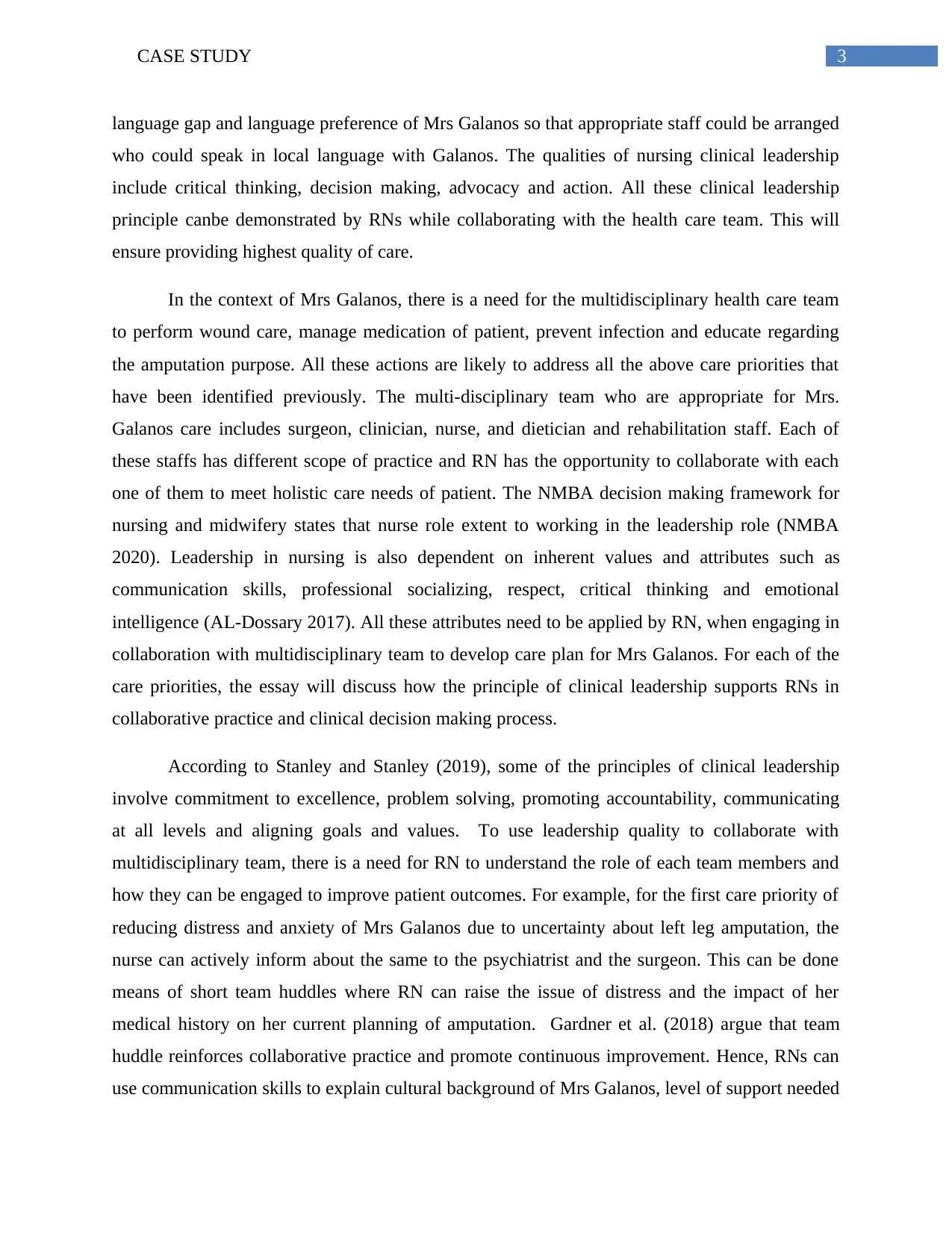
3CASE STUDY
language gap and language preference of Mrs Galanos so that appropriate staff could be arranged
who could speak in local language with Galanos. The qualities of nursing clinical leadership
include critical thinking, decision making, advocacy and action. All these clinical leadership
principle canbe demonstrated by RNs while collaborating with the health care team. This will
ensure providing highest quality of care.
In the context of Mrs Galanos, there is a need for the multidisciplinary health care team
to perform wound care, manage medication of patient, prevent infection and educate regarding
the amputation purpose. All these actions are likely to address all the above care priorities that
have been identified previously. The multi-disciplinary team who are appropriate for Mrs.
Galanos care includes surgeon, clinician, nurse, and dietician and rehabilitation staff. Each of
these staffs has different scope of practice and RN has the opportunity to collaborate with each
one of them to meet holistic care needs of patient. The NMBA decision making framework for
nursing and midwifery states that nurse role extent to working in the leadership role (NMBA
2020). Leadership in nursing is also dependent on inherent values and attributes such as
communication skills, professional socializing, respect, critical thinking and emotional
intelligence (AL-Dossary 2017). All these attributes need to be applied by RN, when engaging in
collaboration with multidisciplinary team to develop care plan for Mrs Galanos. For each of the
care priorities, the essay will discuss how the principle of clinical leadership supports RNs in
collaborative practice and clinical decision making process.
According to Stanley and Stanley (2019), some of the principles of clinical leadership
involve commitment to excellence, problem solving, promoting accountability, communicating
at all levels and aligning goals and values. To use leadership quality to collaborate with
multidisciplinary team, there is a need for RN to understand the role of each team members and
how they can be engaged to improve patient outcomes. For example, for the first care priority of
reducing distress and anxiety of Mrs Galanos due to uncertainty about left leg amputation, the
nurse can actively inform about the same to the psychiatrist and the surgeon. This can be done
means of short team huddles where RN can raise the issue of distress and the impact of her
medical history on her current planning of amputation. Gardner et al. (2018) argue that team
huddle reinforces collaborative practice and promote continuous improvement. Hence, RNs can
use communication skills to explain cultural background of Mrs Galanos, level of support needed
language gap and language preference of Mrs Galanos so that appropriate staff could be arranged
who could speak in local language with Galanos. The qualities of nursing clinical leadership
include critical thinking, decision making, advocacy and action. All these clinical leadership
principle canbe demonstrated by RNs while collaborating with the health care team. This will
ensure providing highest quality of care.
In the context of Mrs Galanos, there is a need for the multidisciplinary health care team
to perform wound care, manage medication of patient, prevent infection and educate regarding
the amputation purpose. All these actions are likely to address all the above care priorities that
have been identified previously. The multi-disciplinary team who are appropriate for Mrs.
Galanos care includes surgeon, clinician, nurse, and dietician and rehabilitation staff. Each of
these staffs has different scope of practice and RN has the opportunity to collaborate with each
one of them to meet holistic care needs of patient. The NMBA decision making framework for
nursing and midwifery states that nurse role extent to working in the leadership role (NMBA
2020). Leadership in nursing is also dependent on inherent values and attributes such as
communication skills, professional socializing, respect, critical thinking and emotional
intelligence (AL-Dossary 2017). All these attributes need to be applied by RN, when engaging in
collaboration with multidisciplinary team to develop care plan for Mrs Galanos. For each of the
care priorities, the essay will discuss how the principle of clinical leadership supports RNs in
collaborative practice and clinical decision making process.
According to Stanley and Stanley (2019), some of the principles of clinical leadership
involve commitment to excellence, problem solving, promoting accountability, communicating
at all levels and aligning goals and values. To use leadership quality to collaborate with
multidisciplinary team, there is a need for RN to understand the role of each team members and
how they can be engaged to improve patient outcomes. For example, for the first care priority of
reducing distress and anxiety of Mrs Galanos due to uncertainty about left leg amputation, the
nurse can actively inform about the same to the psychiatrist and the surgeon. This can be done
means of short team huddles where RN can raise the issue of distress and the impact of her
medical history on her current planning of amputation. Gardner et al. (2018) argue that team
huddle reinforces collaborative practice and promote continuous improvement. Hence, RNs can
use communication skills to explain cultural background of Mrs Galanos, level of support needed
Paraphrase This Document
Need a fresh take? Get an instant paraphrase of this document with our AI Paraphraser
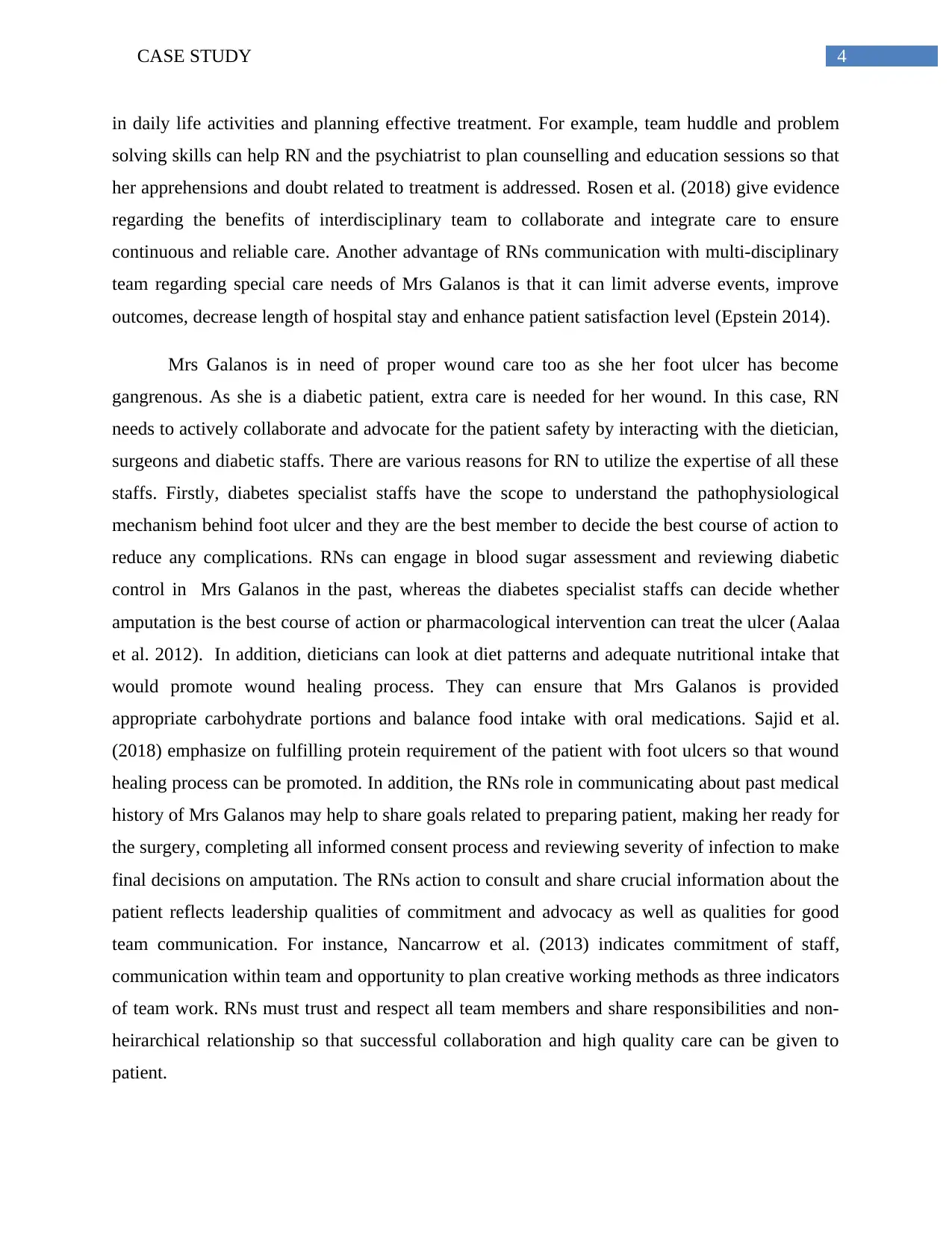
4CASE STUDY
in daily life activities and planning effective treatment. For example, team huddle and problem
solving skills can help RN and the psychiatrist to plan counselling and education sessions so that
her apprehensions and doubt related to treatment is addressed. Rosen et al. (2018) give evidence
regarding the benefits of interdisciplinary team to collaborate and integrate care to ensure
continuous and reliable care. Another advantage of RNs communication with multi-disciplinary
team regarding special care needs of Mrs Galanos is that it can limit adverse events, improve
outcomes, decrease length of hospital stay and enhance patient satisfaction level (Epstein 2014).
Mrs Galanos is in need of proper wound care too as she her foot ulcer has become
gangrenous. As she is a diabetic patient, extra care is needed for her wound. In this case, RN
needs to actively collaborate and advocate for the patient safety by interacting with the dietician,
surgeons and diabetic staffs. There are various reasons for RN to utilize the expertise of all these
staffs. Firstly, diabetes specialist staffs have the scope to understand the pathophysiological
mechanism behind foot ulcer and they are the best member to decide the best course of action to
reduce any complications. RNs can engage in blood sugar assessment and reviewing diabetic
control in Mrs Galanos in the past, whereas the diabetes specialist staffs can decide whether
amputation is the best course of action or pharmacological intervention can treat the ulcer (Aalaa
et al. 2012). In addition, dieticians can look at diet patterns and adequate nutritional intake that
would promote wound healing process. They can ensure that Mrs Galanos is provided
appropriate carbohydrate portions and balance food intake with oral medications. Sajid et al.
(2018) emphasize on fulfilling protein requirement of the patient with foot ulcers so that wound
healing process can be promoted. In addition, the RNs role in communicating about past medical
history of Mrs Galanos may help to share goals related to preparing patient, making her ready for
the surgery, completing all informed consent process and reviewing severity of infection to make
final decisions on amputation. The RNs action to consult and share crucial information about the
patient reflects leadership qualities of commitment and advocacy as well as qualities for good
team communication. For instance, Nancarrow et al. (2013) indicates commitment of staff,
communication within team and opportunity to plan creative working methods as three indicators
of team work. RNs must trust and respect all team members and share responsibilities and non-
heirarchical relationship so that successful collaboration and high quality care can be given to
patient.
in daily life activities and planning effective treatment. For example, team huddle and problem
solving skills can help RN and the psychiatrist to plan counselling and education sessions so that
her apprehensions and doubt related to treatment is addressed. Rosen et al. (2018) give evidence
regarding the benefits of interdisciplinary team to collaborate and integrate care to ensure
continuous and reliable care. Another advantage of RNs communication with multi-disciplinary
team regarding special care needs of Mrs Galanos is that it can limit adverse events, improve
outcomes, decrease length of hospital stay and enhance patient satisfaction level (Epstein 2014).
Mrs Galanos is in need of proper wound care too as she her foot ulcer has become
gangrenous. As she is a diabetic patient, extra care is needed for her wound. In this case, RN
needs to actively collaborate and advocate for the patient safety by interacting with the dietician,
surgeons and diabetic staffs. There are various reasons for RN to utilize the expertise of all these
staffs. Firstly, diabetes specialist staffs have the scope to understand the pathophysiological
mechanism behind foot ulcer and they are the best member to decide the best course of action to
reduce any complications. RNs can engage in blood sugar assessment and reviewing diabetic
control in Mrs Galanos in the past, whereas the diabetes specialist staffs can decide whether
amputation is the best course of action or pharmacological intervention can treat the ulcer (Aalaa
et al. 2012). In addition, dieticians can look at diet patterns and adequate nutritional intake that
would promote wound healing process. They can ensure that Mrs Galanos is provided
appropriate carbohydrate portions and balance food intake with oral medications. Sajid et al.
(2018) emphasize on fulfilling protein requirement of the patient with foot ulcers so that wound
healing process can be promoted. In addition, the RNs role in communicating about past medical
history of Mrs Galanos may help to share goals related to preparing patient, making her ready for
the surgery, completing all informed consent process and reviewing severity of infection to make
final decisions on amputation. The RNs action to consult and share crucial information about the
patient reflects leadership qualities of commitment and advocacy as well as qualities for good
team communication. For instance, Nancarrow et al. (2013) indicates commitment of staff,
communication within team and opportunity to plan creative working methods as three indicators
of team work. RNs must trust and respect all team members and share responsibilities and non-
heirarchical relationship so that successful collaboration and high quality care can be given to
patient.
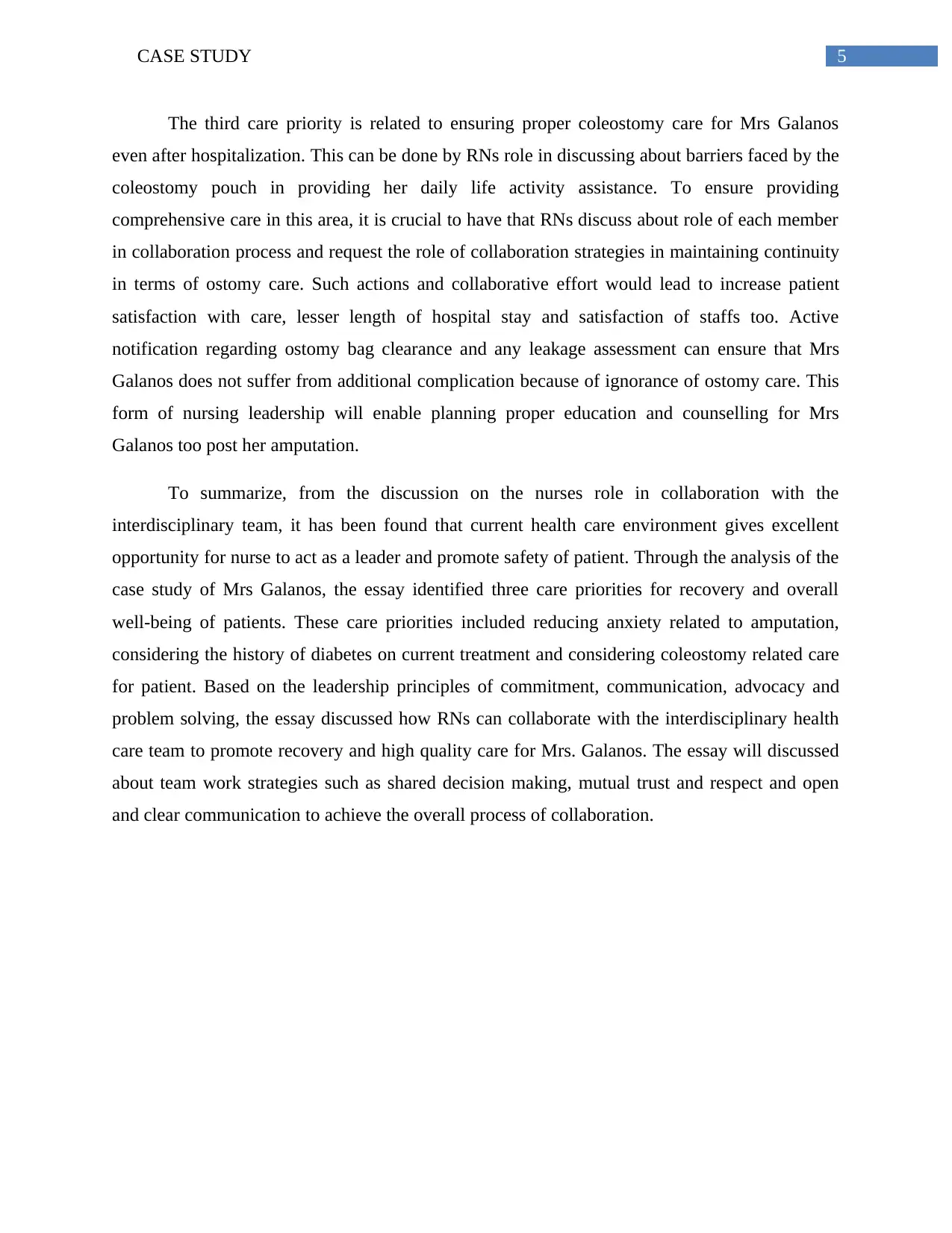
5CASE STUDY
The third care priority is related to ensuring proper coleostomy care for Mrs Galanos
even after hospitalization. This can be done by RNs role in discussing about barriers faced by the
coleostomy pouch in providing her daily life activity assistance. To ensure providing
comprehensive care in this area, it is crucial to have that RNs discuss about role of each member
in collaboration process and request the role of collaboration strategies in maintaining continuity
in terms of ostomy care. Such actions and collaborative effort would lead to increase patient
satisfaction with care, lesser length of hospital stay and satisfaction of staffs too. Active
notification regarding ostomy bag clearance and any leakage assessment can ensure that Mrs
Galanos does not suffer from additional complication because of ignorance of ostomy care. This
form of nursing leadership will enable planning proper education and counselling for Mrs
Galanos too post her amputation.
To summarize, from the discussion on the nurses role in collaboration with the
interdisciplinary team, it has been found that current health care environment gives excellent
opportunity for nurse to act as a leader and promote safety of patient. Through the analysis of the
case study of Mrs Galanos, the essay identified three care priorities for recovery and overall
well-being of patients. These care priorities included reducing anxiety related to amputation,
considering the history of diabetes on current treatment and considering coleostomy related care
for patient. Based on the leadership principles of commitment, communication, advocacy and
problem solving, the essay discussed how RNs can collaborate with the interdisciplinary health
care team to promote recovery and high quality care for Mrs. Galanos. The essay will discussed
about team work strategies such as shared decision making, mutual trust and respect and open
and clear communication to achieve the overall process of collaboration.
The third care priority is related to ensuring proper coleostomy care for Mrs Galanos
even after hospitalization. This can be done by RNs role in discussing about barriers faced by the
coleostomy pouch in providing her daily life activity assistance. To ensure providing
comprehensive care in this area, it is crucial to have that RNs discuss about role of each member
in collaboration process and request the role of collaboration strategies in maintaining continuity
in terms of ostomy care. Such actions and collaborative effort would lead to increase patient
satisfaction with care, lesser length of hospital stay and satisfaction of staffs too. Active
notification regarding ostomy bag clearance and any leakage assessment can ensure that Mrs
Galanos does not suffer from additional complication because of ignorance of ostomy care. This
form of nursing leadership will enable planning proper education and counselling for Mrs
Galanos too post her amputation.
To summarize, from the discussion on the nurses role in collaboration with the
interdisciplinary team, it has been found that current health care environment gives excellent
opportunity for nurse to act as a leader and promote safety of patient. Through the analysis of the
case study of Mrs Galanos, the essay identified three care priorities for recovery and overall
well-being of patients. These care priorities included reducing anxiety related to amputation,
considering the history of diabetes on current treatment and considering coleostomy related care
for patient. Based on the leadership principles of commitment, communication, advocacy and
problem solving, the essay discussed how RNs can collaborate with the interdisciplinary health
care team to promote recovery and high quality care for Mrs. Galanos. The essay will discussed
about team work strategies such as shared decision making, mutual trust and respect and open
and clear communication to achieve the overall process of collaboration.
⊘ This is a preview!⊘
Do you want full access?
Subscribe today to unlock all pages.

Trusted by 1+ million students worldwide
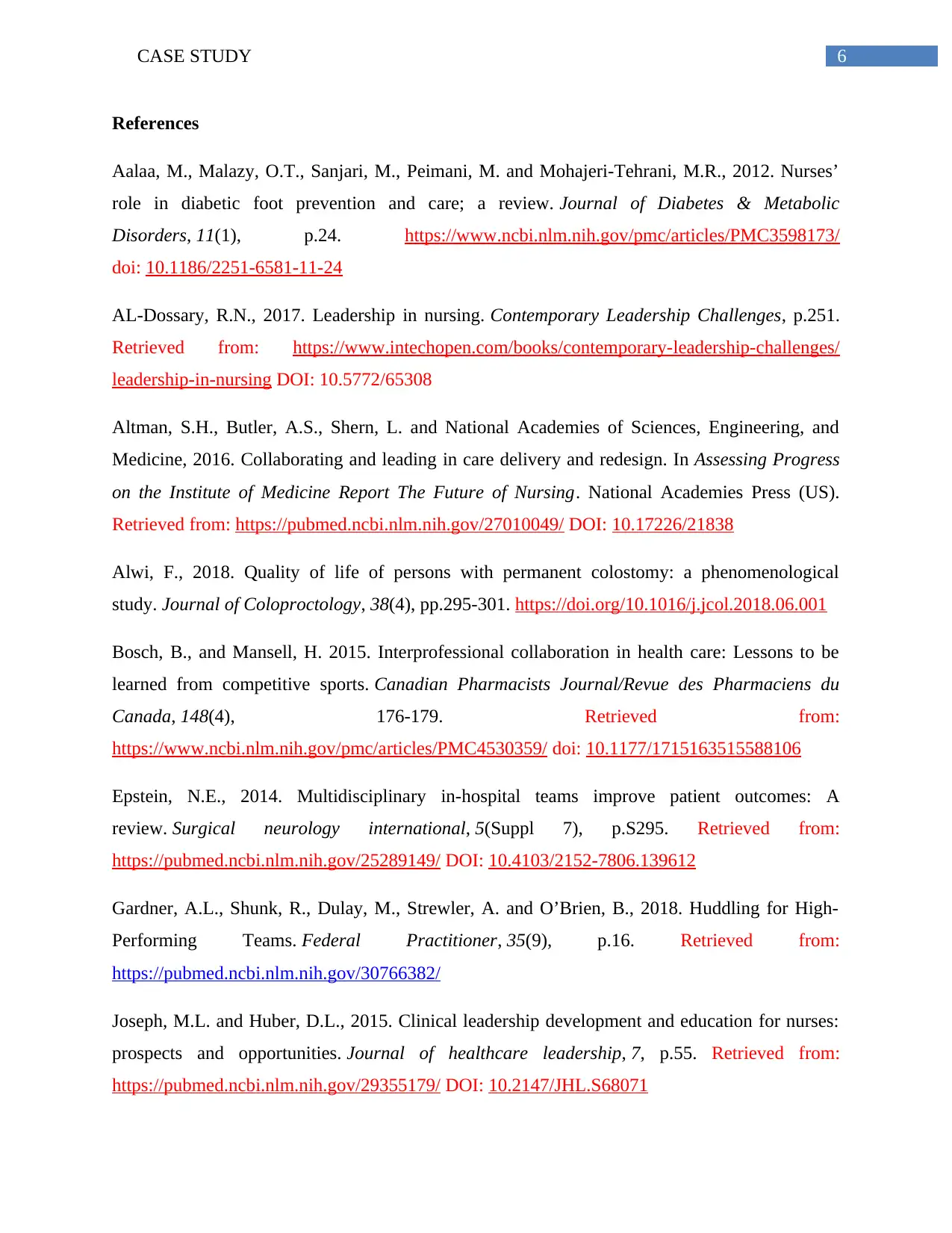
6CASE STUDY
References
Aalaa, M., Malazy, O.T., Sanjari, M., Peimani, M. and Mohajeri-Tehrani, M.R., 2012. Nurses’
role in diabetic foot prevention and care; a review. Journal of Diabetes & Metabolic
Disorders, 11(1), p.24. https://www.ncbi.nlm.nih.gov/pmc/articles/PMC3598173/
doi: 10.1186/2251-6581-11-24
AL-Dossary, R.N., 2017. Leadership in nursing. Contemporary Leadership Challenges, p.251.
Retrieved from: https://www.intechopen.com/books/contemporary-leadership-challenges/
leadership-in-nursing DOI: 10.5772/65308
Altman, S.H., Butler, A.S., Shern, L. and National Academies of Sciences, Engineering, and
Medicine, 2016. Collaborating and leading in care delivery and redesign. In Assessing Progress
on the Institute of Medicine Report The Future of Nursing. National Academies Press (US).
Retrieved from: https://pubmed.ncbi.nlm.nih.gov/27010049/ DOI: 10.17226/21838
Alwi, F., 2018. Quality of life of persons with permanent colostomy: a phenomenological
study. Journal of Coloproctology, 38(4), pp.295-301. https://doi.org/10.1016/j.jcol.2018.06.001
Bosch, B., and Mansell, H. 2015. Interprofessional collaboration in health care: Lessons to be
learned from competitive sports. Canadian Pharmacists Journal/Revue des Pharmaciens du
Canada, 148(4), 176-179. Retrieved from:
https://www.ncbi.nlm.nih.gov/pmc/articles/PMC4530359/ doi: 10.1177/1715163515588106
Epstein, N.E., 2014. Multidisciplinary in-hospital teams improve patient outcomes: A
review. Surgical neurology international, 5(Suppl 7), p.S295. Retrieved from:
https://pubmed.ncbi.nlm.nih.gov/25289149/ DOI: 10.4103/2152-7806.139612
Gardner, A.L., Shunk, R., Dulay, M., Strewler, A. and O’Brien, B., 2018. Huddling for High-
Performing Teams. Federal Practitioner, 35(9), p.16. Retrieved from:
https://pubmed.ncbi.nlm.nih.gov/30766382/
Joseph, M.L. and Huber, D.L., 2015. Clinical leadership development and education for nurses:
prospects and opportunities. Journal of healthcare leadership, 7, p.55. Retrieved from:
https://pubmed.ncbi.nlm.nih.gov/29355179/ DOI: 10.2147/JHL.S68071
References
Aalaa, M., Malazy, O.T., Sanjari, M., Peimani, M. and Mohajeri-Tehrani, M.R., 2012. Nurses’
role in diabetic foot prevention and care; a review. Journal of Diabetes & Metabolic
Disorders, 11(1), p.24. https://www.ncbi.nlm.nih.gov/pmc/articles/PMC3598173/
doi: 10.1186/2251-6581-11-24
AL-Dossary, R.N., 2017. Leadership in nursing. Contemporary Leadership Challenges, p.251.
Retrieved from: https://www.intechopen.com/books/contemporary-leadership-challenges/
leadership-in-nursing DOI: 10.5772/65308
Altman, S.H., Butler, A.S., Shern, L. and National Academies of Sciences, Engineering, and
Medicine, 2016. Collaborating and leading in care delivery and redesign. In Assessing Progress
on the Institute of Medicine Report The Future of Nursing. National Academies Press (US).
Retrieved from: https://pubmed.ncbi.nlm.nih.gov/27010049/ DOI: 10.17226/21838
Alwi, F., 2018. Quality of life of persons with permanent colostomy: a phenomenological
study. Journal of Coloproctology, 38(4), pp.295-301. https://doi.org/10.1016/j.jcol.2018.06.001
Bosch, B., and Mansell, H. 2015. Interprofessional collaboration in health care: Lessons to be
learned from competitive sports. Canadian Pharmacists Journal/Revue des Pharmaciens du
Canada, 148(4), 176-179. Retrieved from:
https://www.ncbi.nlm.nih.gov/pmc/articles/PMC4530359/ doi: 10.1177/1715163515588106
Epstein, N.E., 2014. Multidisciplinary in-hospital teams improve patient outcomes: A
review. Surgical neurology international, 5(Suppl 7), p.S295. Retrieved from:
https://pubmed.ncbi.nlm.nih.gov/25289149/ DOI: 10.4103/2152-7806.139612
Gardner, A.L., Shunk, R., Dulay, M., Strewler, A. and O’Brien, B., 2018. Huddling for High-
Performing Teams. Federal Practitioner, 35(9), p.16. Retrieved from:
https://pubmed.ncbi.nlm.nih.gov/30766382/
Joseph, M.L. and Huber, D.L., 2015. Clinical leadership development and education for nurses:
prospects and opportunities. Journal of healthcare leadership, 7, p.55. Retrieved from:
https://pubmed.ncbi.nlm.nih.gov/29355179/ DOI: 10.2147/JHL.S68071
Paraphrase This Document
Need a fresh take? Get an instant paraphrase of this document with our AI Paraphraser
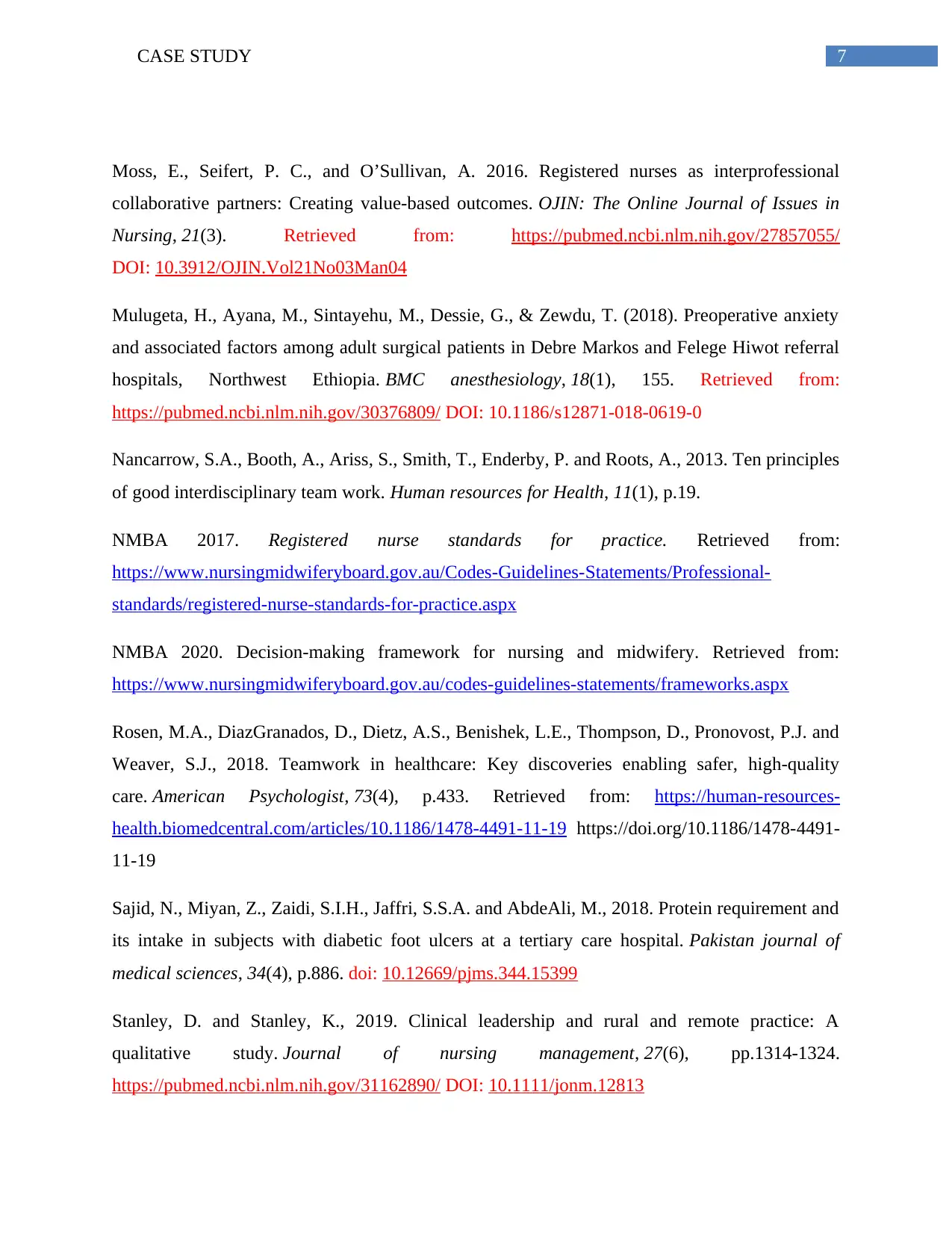
7CASE STUDY
Moss, E., Seifert, P. C., and O’Sullivan, A. 2016. Registered nurses as interprofessional
collaborative partners: Creating value-based outcomes. OJIN: The Online Journal of Issues in
Nursing, 21(3). Retrieved from: https://pubmed.ncbi.nlm.nih.gov/27857055/
DOI: 10.3912/OJIN.Vol21No03Man04
Mulugeta, H., Ayana, M., Sintayehu, M., Dessie, G., & Zewdu, T. (2018). Preoperative anxiety
and associated factors among adult surgical patients in Debre Markos and Felege Hiwot referral
hospitals, Northwest Ethiopia. BMC anesthesiology, 18(1), 155. Retrieved from:
https://pubmed.ncbi.nlm.nih.gov/30376809/ DOI: 10.1186/s12871-018-0619-0
Nancarrow, S.A., Booth, A., Ariss, S., Smith, T., Enderby, P. and Roots, A., 2013. Ten principles
of good interdisciplinary team work. Human resources for Health, 11(1), p.19.
NMBA 2017. Registered nurse standards for practice. Retrieved from:
https://www.nursingmidwiferyboard.gov.au/Codes-Guidelines-Statements/Professional-
standards/registered-nurse-standards-for-practice.aspx
NMBA 2020. Decision-making framework for nursing and midwifery. Retrieved from:
https://www.nursingmidwiferyboard.gov.au/codes-guidelines-statements/frameworks.aspx
Rosen, M.A., DiazGranados, D., Dietz, A.S., Benishek, L.E., Thompson, D., Pronovost, P.J. and
Weaver, S.J., 2018. Teamwork in healthcare: Key discoveries enabling safer, high-quality
care. American Psychologist, 73(4), p.433. Retrieved from: https://human-resources-
health.biomedcentral.com/articles/10.1186/1478-4491-11-19 https://doi.org/10.1186/1478-4491-
11-19
Sajid, N., Miyan, Z., Zaidi, S.I.H., Jaffri, S.S.A. and AbdeAli, M., 2018. Protein requirement and
its intake in subjects with diabetic foot ulcers at a tertiary care hospital. Pakistan journal of
medical sciences, 34(4), p.886. doi: 10.12669/pjms.344.15399
Stanley, D. and Stanley, K., 2019. Clinical leadership and rural and remote practice: A
qualitative study. Journal of nursing management, 27(6), pp.1314-1324.
https://pubmed.ncbi.nlm.nih.gov/31162890/ DOI: 10.1111/jonm.12813
Moss, E., Seifert, P. C., and O’Sullivan, A. 2016. Registered nurses as interprofessional
collaborative partners: Creating value-based outcomes. OJIN: The Online Journal of Issues in
Nursing, 21(3). Retrieved from: https://pubmed.ncbi.nlm.nih.gov/27857055/
DOI: 10.3912/OJIN.Vol21No03Man04
Mulugeta, H., Ayana, M., Sintayehu, M., Dessie, G., & Zewdu, T. (2018). Preoperative anxiety
and associated factors among adult surgical patients in Debre Markos and Felege Hiwot referral
hospitals, Northwest Ethiopia. BMC anesthesiology, 18(1), 155. Retrieved from:
https://pubmed.ncbi.nlm.nih.gov/30376809/ DOI: 10.1186/s12871-018-0619-0
Nancarrow, S.A., Booth, A., Ariss, S., Smith, T., Enderby, P. and Roots, A., 2013. Ten principles
of good interdisciplinary team work. Human resources for Health, 11(1), p.19.
NMBA 2017. Registered nurse standards for practice. Retrieved from:
https://www.nursingmidwiferyboard.gov.au/Codes-Guidelines-Statements/Professional-
standards/registered-nurse-standards-for-practice.aspx
NMBA 2020. Decision-making framework for nursing and midwifery. Retrieved from:
https://www.nursingmidwiferyboard.gov.au/codes-guidelines-statements/frameworks.aspx
Rosen, M.A., DiazGranados, D., Dietz, A.S., Benishek, L.E., Thompson, D., Pronovost, P.J. and
Weaver, S.J., 2018. Teamwork in healthcare: Key discoveries enabling safer, high-quality
care. American Psychologist, 73(4), p.433. Retrieved from: https://human-resources-
health.biomedcentral.com/articles/10.1186/1478-4491-11-19 https://doi.org/10.1186/1478-4491-
11-19
Sajid, N., Miyan, Z., Zaidi, S.I.H., Jaffri, S.S.A. and AbdeAli, M., 2018. Protein requirement and
its intake in subjects with diabetic foot ulcers at a tertiary care hospital. Pakistan journal of
medical sciences, 34(4), p.886. doi: 10.12669/pjms.344.15399
Stanley, D. and Stanley, K., 2019. Clinical leadership and rural and remote practice: A
qualitative study. Journal of nursing management, 27(6), pp.1314-1324.
https://pubmed.ncbi.nlm.nih.gov/31162890/ DOI: 10.1111/jonm.12813

8CASE STUDY
⊘ This is a preview!⊘
Do you want full access?
Subscribe today to unlock all pages.

Trusted by 1+ million students worldwide
1 out of 9
Related Documents
Your All-in-One AI-Powered Toolkit for Academic Success.
+13062052269
info@desklib.com
Available 24*7 on WhatsApp / Email
![[object Object]](/_next/static/media/star-bottom.7253800d.svg)
Unlock your academic potential
Copyright © 2020–2025 A2Z Services. All Rights Reserved. Developed and managed by ZUCOL.





